With so much travel involved in the Grand Tour, and with the Wenlock Heir's predisposition to spend the heat of the day splashing around in swimming pools, and with such trips being, in principle, about relaxation and enjoyment, selecting the right reading matter was an important part of holiday planning in the Wenlock household. I wanted, as far as possible, books that would give me a feel for the places we were visiting: Rome, Florence and Siena. For Florence a useful starting point was
Fictional Cities, which is perhaps why I did better on that city than on the other two.
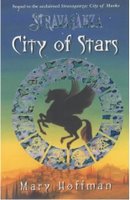
The one book that covered Siena was Mary Hoffman's
City of Stars. This is the second in the
Stravaganza series, young adult books set in an alternative 16th Century Italy and involving visitors from 21st Century North London to a world dominated by the De Chimici family. The focus of
City of Stars is a version of the Palio, Siena's famous horse race (of which much more in another post). The third book,
City of Flowers, addresses an alternative Florence, and the machinations of the head of the De Chimici family, which bare considerable similarities to aspects of de Medici activities. Highly recommended.
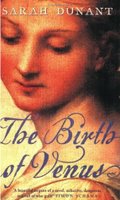
Sarah Dunant's
The Birth of Venus is a brilliant capturing of late 15th Century Florence, when the de Medicis were briefly eclipsed, folowing the death of Lorenzo the Magnificent, by both the invading armies of the Holy Roman Emperor and by the fanatical preaching of Giralamo Savonarola. She captures the growing menace of Savonarola's rabble rousing, the approaching French army, and the threat of plague brilliantly, entwining it around a brilliantly characterised heroine. I found this book a real page-turner, but one that was also deeply satisfying to look back upon; a rare combination.
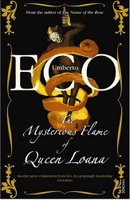
Mark, at
Mostly Books, suggested Umberto Eco's
The Mysterious Flame of Queen Loana, although it is not set in Rome, Florence or Siena. I have read and enjoyed all of Eco's earlier novels (of which
Baudolino might have been the most relevant to this trip) and had planned to read this one at some point anyway, so Mark did not need to nudge me very hard. Like all of Eco's books it contains plenty of philosophical speculation, on identity and memory in particular. The protagonist is a man who has lost his memory of his own life, but not of all the facts that he has learned through the years. Eco uses this device, among other things, to explore the Italian national psyche during the Second World War, and how this was reflected in popular culture - comic books, popular music and so on. If this makes it all sound very dry, it shouldn't do. It was a wonderful book and, unusually for a novel, it is richly illustrated with examples of the popular culture which it discusses. I learned a great deal from it about Italy in the second quarter of the last Century.

I picked Christobel Kent's story of goings on among the English expat community in Florence,
A Party in San Niccolo, from the
review on Fictional Cities and I was not disappointed. As the review makes clear this is a book that contains murder and mystery without being a murder mystery. It helped give me a feel for Florence before we arrived, but the story takes place in the spring, when the streets of town are not packed with tourists, whose activities rather drown out any sense of what the city is like to live in year-round.

Judy Astley's
Blowing It was a complete break from Italy, but was just the sort of book to read while dealing long-distance with insurance companies and others while sorting out Mrs Wenlock's emergency flight home. Judy claims that it is not one of her best, but it is still a well-constructed tale of a slightly unconventional family almost falling apart and eventually sorting themselves out. The central character, Lottie, is married to the former lead singer of a 70s soft rock band (Charisma, described as a cross between
Fairport Convention and
Fleetwood Mac, which I still struggle to imagine). Their philosophy of life tends to involve throwing themselves into new ventures without much thought for the consequences, and with the income from Charisma's back catalogue falling their latest plan, to have a "gap year" themselves, now that their youngest child is about to do the same before University, involves selling the huge but crumbling family home, to the horror of their somewhat conventional children.
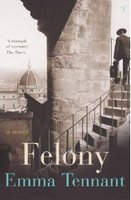
I found Emma Tennant's
Felony in the BM Bookstore in Florence. It has to count as liteary fiction on many levels. It tells of Claire Clairmont's last days in the late 19th Century. Clairmont was a friend and lover of Byron and Shelley, and was with them at the Villa Diodati near Geneva when Mary Shelley wrote
Frankenstein and John Polidori wrote
The Vampyre. In her eighties she lived in Florence where she was preyed upon by an American sea captain with a Shelley obsession who hoped to inherit her papers when she died. This (true) story was the inspiration for Henry James'
The Aspern Papers, and Tennant weaves an account of James researching and writing that book in the 1880s with Clairmont's woes in the 1870s. Interesting, if not quite as gripping as Dunant's story.
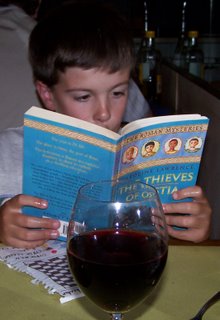
Meanwhile the Wenlock Heir, having visited the site of Ostia Antica, spent his free hours devouring the series of
Roman Mysteries written by Caroline Lawrence. He found these so gripping that he would bring them along to restaurants, and at times would choose reading over splashing about in the pool. He worked his way through five of the series and would have read more if I could have found them in the local shops.
 The one book that covered Siena was Mary Hoffman's City of Stars. This is the second in the Stravaganza series, young adult books set in an alternative 16th Century Italy and involving visitors from 21st Century North London to a world dominated by the De Chimici family. The focus of City of Stars is a version of the Palio, Siena's famous horse race (of which much more in another post). The third book, City of Flowers, addresses an alternative Florence, and the machinations of the head of the De Chimici family, which bare considerable similarities to aspects of de Medici activities. Highly recommended.
The one book that covered Siena was Mary Hoffman's City of Stars. This is the second in the Stravaganza series, young adult books set in an alternative 16th Century Italy and involving visitors from 21st Century North London to a world dominated by the De Chimici family. The focus of City of Stars is a version of the Palio, Siena's famous horse race (of which much more in another post). The third book, City of Flowers, addresses an alternative Florence, and the machinations of the head of the De Chimici family, which bare considerable similarities to aspects of de Medici activities. Highly recommended. Sarah Dunant's The Birth of Venus is a brilliant capturing of late 15th Century Florence, when the de Medicis were briefly eclipsed, folowing the death of Lorenzo the Magnificent, by both the invading armies of the Holy Roman Emperor and by the fanatical preaching of Giralamo Savonarola. She captures the growing menace of Savonarola's rabble rousing, the approaching French army, and the threat of plague brilliantly, entwining it around a brilliantly characterised heroine. I found this book a real page-turner, but one that was also deeply satisfying to look back upon; a rare combination.
Sarah Dunant's The Birth of Venus is a brilliant capturing of late 15th Century Florence, when the de Medicis were briefly eclipsed, folowing the death of Lorenzo the Magnificent, by both the invading armies of the Holy Roman Emperor and by the fanatical preaching of Giralamo Savonarola. She captures the growing menace of Savonarola's rabble rousing, the approaching French army, and the threat of plague brilliantly, entwining it around a brilliantly characterised heroine. I found this book a real page-turner, but one that was also deeply satisfying to look back upon; a rare combination. Mark, at Mostly Books, suggested Umberto Eco's The Mysterious Flame of Queen Loana, although it is not set in Rome, Florence or Siena. I have read and enjoyed all of Eco's earlier novels (of which Baudolino might have been the most relevant to this trip) and had planned to read this one at some point anyway, so Mark did not need to nudge me very hard. Like all of Eco's books it contains plenty of philosophical speculation, on identity and memory in particular. The protagonist is a man who has lost his memory of his own life, but not of all the facts that he has learned through the years. Eco uses this device, among other things, to explore the Italian national psyche during the Second World War, and how this was reflected in popular culture - comic books, popular music and so on. If this makes it all sound very dry, it shouldn't do. It was a wonderful book and, unusually for a novel, it is richly illustrated with examples of the popular culture which it discusses. I learned a great deal from it about Italy in the second quarter of the last Century.
Mark, at Mostly Books, suggested Umberto Eco's The Mysterious Flame of Queen Loana, although it is not set in Rome, Florence or Siena. I have read and enjoyed all of Eco's earlier novels (of which Baudolino might have been the most relevant to this trip) and had planned to read this one at some point anyway, so Mark did not need to nudge me very hard. Like all of Eco's books it contains plenty of philosophical speculation, on identity and memory in particular. The protagonist is a man who has lost his memory of his own life, but not of all the facts that he has learned through the years. Eco uses this device, among other things, to explore the Italian national psyche during the Second World War, and how this was reflected in popular culture - comic books, popular music and so on. If this makes it all sound very dry, it shouldn't do. It was a wonderful book and, unusually for a novel, it is richly illustrated with examples of the popular culture which it discusses. I learned a great deal from it about Italy in the second quarter of the last Century. I picked Christobel Kent's story of goings on among the English expat community in Florence, A Party in San Niccolo, from the review on Fictional Cities and I was not disappointed. As the review makes clear this is a book that contains murder and mystery without being a murder mystery. It helped give me a feel for Florence before we arrived, but the story takes place in the spring, when the streets of town are not packed with tourists, whose activities rather drown out any sense of what the city is like to live in year-round.
I picked Christobel Kent's story of goings on among the English expat community in Florence, A Party in San Niccolo, from the review on Fictional Cities and I was not disappointed. As the review makes clear this is a book that contains murder and mystery without being a murder mystery. It helped give me a feel for Florence before we arrived, but the story takes place in the spring, when the streets of town are not packed with tourists, whose activities rather drown out any sense of what the city is like to live in year-round. Judy Astley's Blowing It was a complete break from Italy, but was just the sort of book to read while dealing long-distance with insurance companies and others while sorting out Mrs Wenlock's emergency flight home. Judy claims that it is not one of her best, but it is still a well-constructed tale of a slightly unconventional family almost falling apart and eventually sorting themselves out. The central character, Lottie, is married to the former lead singer of a 70s soft rock band (Charisma, described as a cross between Fairport Convention and Fleetwood Mac, which I still struggle to imagine). Their philosophy of life tends to involve throwing themselves into new ventures without much thought for the consequences, and with the income from Charisma's back catalogue falling their latest plan, to have a "gap year" themselves, now that their youngest child is about to do the same before University, involves selling the huge but crumbling family home, to the horror of their somewhat conventional children.
Judy Astley's Blowing It was a complete break from Italy, but was just the sort of book to read while dealing long-distance with insurance companies and others while sorting out Mrs Wenlock's emergency flight home. Judy claims that it is not one of her best, but it is still a well-constructed tale of a slightly unconventional family almost falling apart and eventually sorting themselves out. The central character, Lottie, is married to the former lead singer of a 70s soft rock band (Charisma, described as a cross between Fairport Convention and Fleetwood Mac, which I still struggle to imagine). Their philosophy of life tends to involve throwing themselves into new ventures without much thought for the consequences, and with the income from Charisma's back catalogue falling their latest plan, to have a "gap year" themselves, now that their youngest child is about to do the same before University, involves selling the huge but crumbling family home, to the horror of their somewhat conventional children. I found Emma Tennant's Felony in the BM Bookstore in Florence. It has to count as liteary fiction on many levels. It tells of Claire Clairmont's last days in the late 19th Century. Clairmont was a friend and lover of Byron and Shelley, and was with them at the Villa Diodati near Geneva when Mary Shelley wrote Frankenstein and John Polidori wrote The Vampyre. In her eighties she lived in Florence where she was preyed upon by an American sea captain with a Shelley obsession who hoped to inherit her papers when she died. This (true) story was the inspiration for Henry James' The Aspern Papers, and Tennant weaves an account of James researching and writing that book in the 1880s with Clairmont's woes in the 1870s. Interesting, if not quite as gripping as Dunant's story.
I found Emma Tennant's Felony in the BM Bookstore in Florence. It has to count as liteary fiction on many levels. It tells of Claire Clairmont's last days in the late 19th Century. Clairmont was a friend and lover of Byron and Shelley, and was with them at the Villa Diodati near Geneva when Mary Shelley wrote Frankenstein and John Polidori wrote The Vampyre. In her eighties she lived in Florence where she was preyed upon by an American sea captain with a Shelley obsession who hoped to inherit her papers when she died. This (true) story was the inspiration for Henry James' The Aspern Papers, and Tennant weaves an account of James researching and writing that book in the 1880s with Clairmont's woes in the 1870s. Interesting, if not quite as gripping as Dunant's story. Meanwhile the Wenlock Heir, having visited the site of Ostia Antica, spent his free hours devouring the series of Roman Mysteries written by Caroline Lawrence. He found these so gripping that he would bring them along to restaurants, and at times would choose reading over splashing about in the pool. He worked his way through five of the series and would have read more if I could have found them in the local shops.
Meanwhile the Wenlock Heir, having visited the site of Ostia Antica, spent his free hours devouring the series of Roman Mysteries written by Caroline Lawrence. He found these so gripping that he would bring them along to restaurants, and at times would choose reading over splashing about in the pool. He worked his way through five of the series and would have read more if I could have found them in the local shops.

1 comment:
Watch that boy. He'll start writing Roman Mysteries one day. :)
I still blame Rosemary Sutcliff for The Charioteer. Without her books I may have stuck to writing Mediaeval novels.
Post a Comment